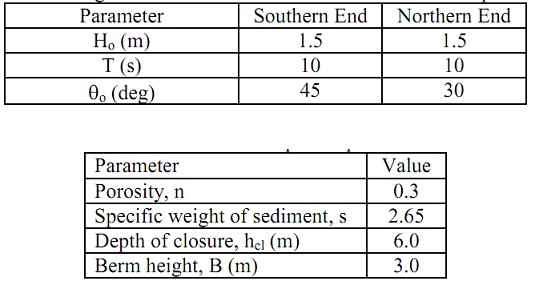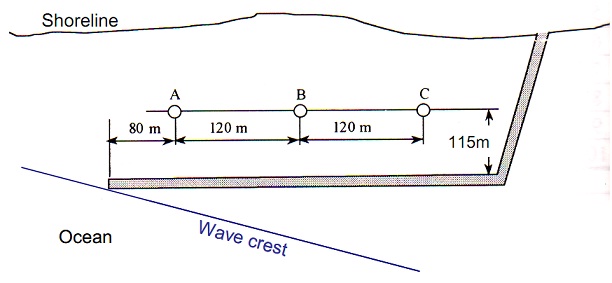Section A: True (T) or False (F)?
1) In deep water, the wave speed is dependent on the wave period and the water depth.
2) At a point underneath a wave trough, the velocity vector points in the direction of wave propagation.
3) A wave spectrum is a plot of wave energy versus time.
4) The barometric setdown associated with a stationary high pressure system is of the order 10cm/hPa.
5) Refraction is the process by which wave energy spreads out along a wave crest from a region of high energy to a region of low energy usually associated with obstructions in the ocean.
6) Assuming a spherical shaped sediment particle will tend to overestimate the settling velocity for natural sand particles.
7) Tsunami waves in the ocean behave as deep water waves.
8) Considering linear wave forcing, the maximum inertial force acting on a pile will coincide with the passing of the wave crest.
9) Given the same free stream velocities, the bed shear stress resulting from wave driven currents is greater than the bed shear stress under a steady, uni-directional current.
10) Wave runup is more dependent on the wave period than the wave height.
Section B: Multiple choice
1) A small-amplitude wave with a period of 11s propagating in a water depth of 2m is a:
(a) transitional wave
(b) shallow water wave
(c) deep water wave
(d) short wave
2) Consider a 10m wind speed of 20.65m/s blowing across a deep water ocean. Assuming that wind duration is not a limiting factor, the minimum fetch length required to reach a fully developed sea state is approximately:
(a) 900km
(b) 1000km
(c) 1100km
(d) 1200km
3) Irregular waves with a period of 12 seconds and Ho,rms = 2.1m runup on a beach with a slope of 1 in 100. How many waves will exceed the R2% elevation in a 2hr period?
(a) 8
(b) 12
(c) 16
(d) 20
4) Consider the head of a rubble mound breakwater made of rough angular quarry stone (ρs = 2650kg/m3) with a slope of 1:2. What is the largest broken wave height that a 1m armour unit could withstand?
(a) 2.3m
(b) 2.5m
(c) 2.8m
(d) 3.2m
5) A bottom mounted pressure sensor is deployed in a water depth of 5m where waves typically have a height of 1m and a period of 9.8s. Relative to the pressure fluctuations at the still water level, how much will the pressure fluctuations at the sensor will be reduced by?
(a) 5%
(b) 10%
(c) 15%
(d) 20%
Section C:
1) Aerial photographs of a 10km section of straight coastline oriented in the north-south direction with the ocean to the east reveal a shoreline accretion rate of 1.2m/year. Assuming that wave breaking occurs in shallow water with a breaker index of 0.8 and that the bottom contours are straight and parallel to the coastline, estimate the average annual shore-normal transport rate.
First table below summarizes the results of an analysis of deep water wave data quantifying the typical conditions for the area. And second table summarises the sediment and profile data.
H = wave height, T = wave period, θ = wave crest angle to coastline.

2) Explain wave set-up and set-down in the nearshore in terms of wave transformation processes and the resultant spatial gradients in the radiation stress.
3) Consider the breakwater configuration shown in the figure below. The incident wave conditions at the breakwater are a wave height of 1.5m, wave period of 7.0s and a wave crest angle to the breakwater of 15o. The water depth in behind the breakwater is constant at h = 4.9m. Provide quantitative evidence to establish whether 0.2mm quartz sediments (ρs = 2650kg/m3, s ≈ 2.65) at location B will move or not.
